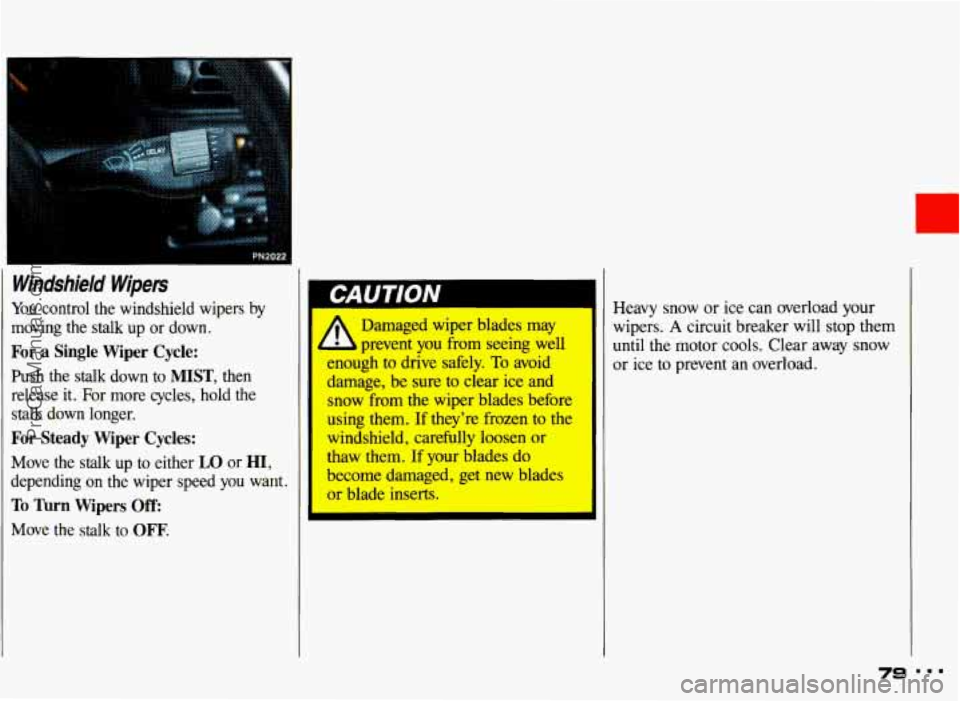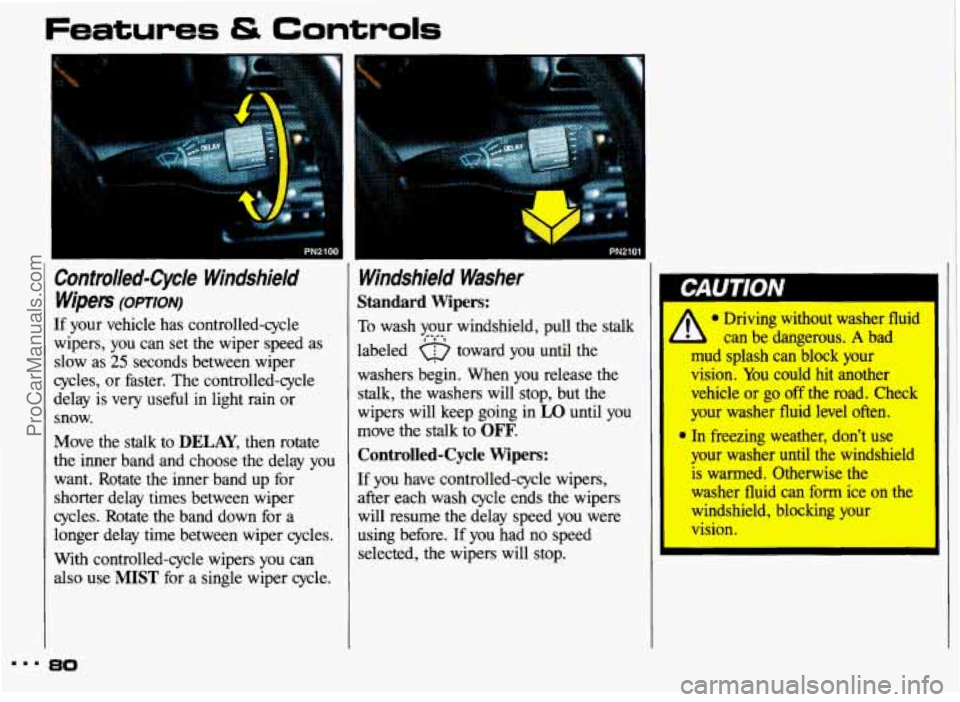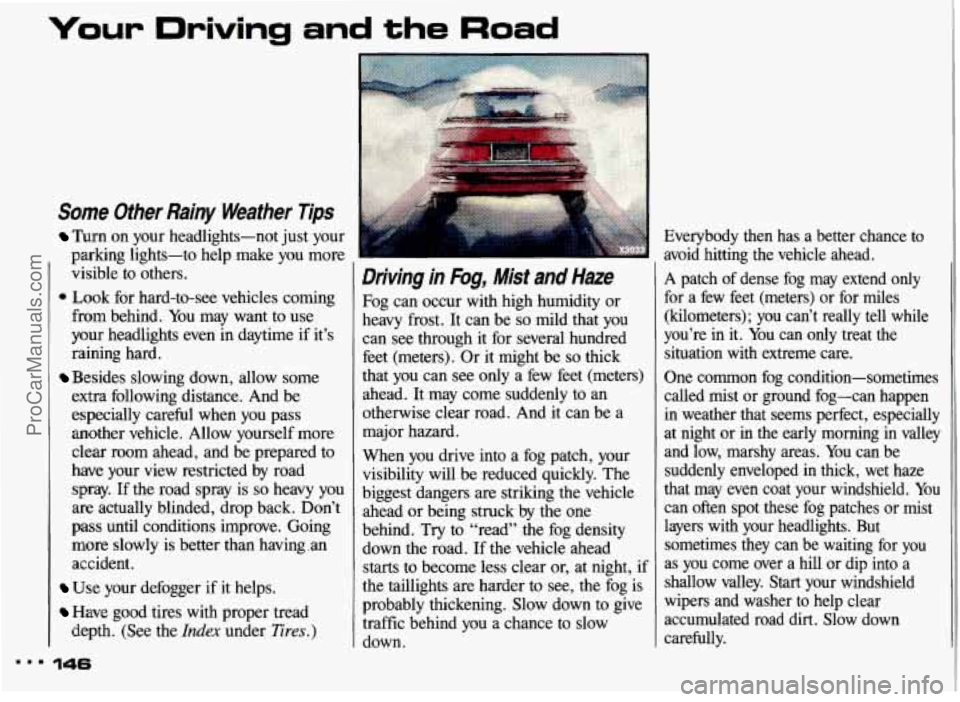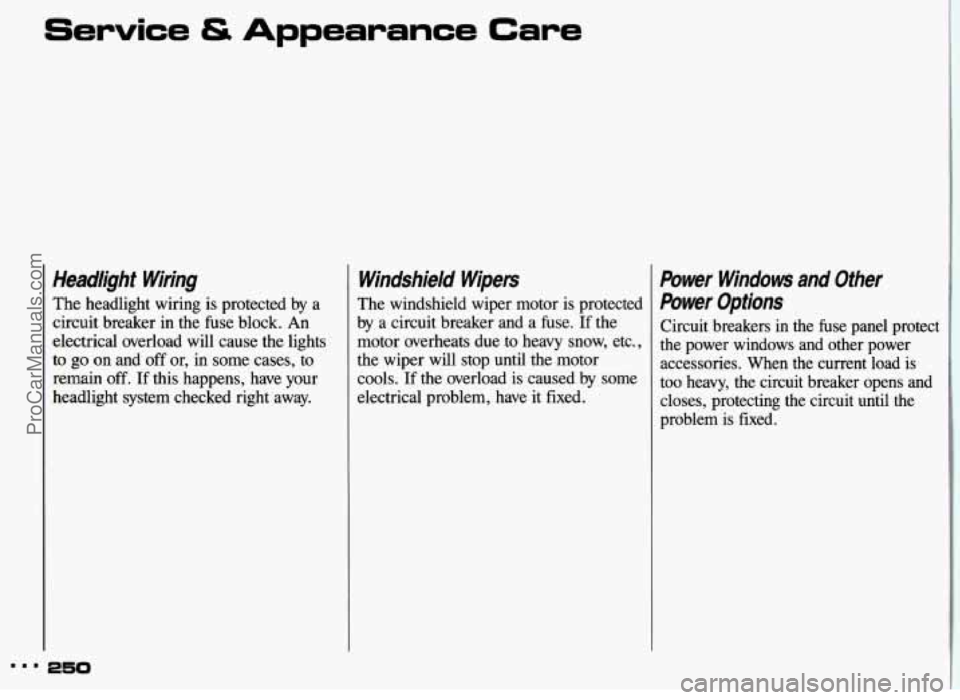1993 PONTIAC GRAND-AM windshield wipers
[x] Cancel search: windshield wipersPage 7 of 306

How to Use this Manual
Vehicle Symbols (CONT.:)
These symbols are on some of your
controls:
Windshield Wipers
Windshield Washer
Windshield Defroster
Rear Window Defogger
Ventilating Fan
Power Window
These symbols are used on warning and
Here are some other symbols you may
indicator lights: see:
Engine Coolant
Temperature
Battery Charging
System
Fuel
Engine Oil Pressure
Brake
Anti-Lock Brakes Fuse
(0)
Speaker
(@I
Hood Release
... 6
ProCarManuals.com
Page 44 of 306

Here you can learn about the
many standard and optional features
on your Pontiac. and information on
starting. shifting and braking
. Also
explained are the instrument panel
and the warning systems that tell
you
if everything is working
properly-and what to do
if you have
a problem
.
Part 2
Features & Controls
Keys .............................. ............................ 44
GloveBox ....................................................... 50
StartingYourEngine
............................................... 52
LOC
ks ........................................................... 45
Ignitionswitch
.................................................... 51
Engine Block Heater
............................................... 56
Shifting the Transaxle
.............................................. 57
ShiftingIntoPark
.................................................. 64
Turn SignaVHeadlight Beam Lever .................................... 69
Cruisecontrol .................................................... 70
Lightcontrols
.................................................... 74
Interior Lights
.................................................... 76
Windshield Wipers
................................................. 79
Windshield Washer ................................................ 80
Mirrors .......................................................... 81
Ashtray and Lighter ................................................ 85
Warning Lights, Gages and Indicators .................................. 91
ParkingBrake
.................................................... 63
Windows
........................................................ 68
Sunvisors
....................................................... 82
InstrumentPanel
.................................................. 86
ProCarManuals.com
Page 75 of 306

Features & Controls
I
I'
To Get Out of Cruise Control
There are two ways to turn off the cruise
control:
Step lightly on the brake pedal or push
the clutch pedal, if you have
a manual
transaxle; OR
Move the cruise switch to OFF.
To Erase Cruise Speed Memory
When you turn off the cruise control or
the ignition, your cruise control set
speed memory is erased.
74
. .. .. .. . , .. PN210!
Light Controls
Parking Lights:
Rotate the switch up to pf to turn on
Parking Lights
Side Marker Lights
Taillights
Instrument Panel Lights
Headlights:
Rotate the switch to , , ,- to turn on:
Headlights
Parking Lights
Side Marker Lights
Taillights
Instrument Panel Lights
Rotate the switch
to OF" to turn all the
lights off.
-'D
Operation of Lights
Although your vehicle's lighting system
(headlamps, parking lamps, fog lamps,
side marker lamps and taillamps) meets
all applicable federal lighting requirements,
certain states and provinces may apply
their own lighting regulations that may
require special attention before you
operate these lamps. For example, some
jurisdictions may require that you
operate your lower beam lamps with fog
lamps at all times, or that headlamps be
turned
on whenever you must use your
windshield wipers.
In addition, most
jurisdictions prohibit driving solely with
parking lamps, especially at dawn
or
dusk. It is recommended that you check
with your own state
or provincial
highway authority for applicable lighting
regulations.
c ProCarManuals.com
Page 80 of 306

Windshield Wipers
You control the windshield wipers by
moving the stalk up or down.
For a Single Wiper Cycle:
Push the stalk down to MIST, then
release it. For more cycles, hold the
stalk down longer.
For Steady Wiper Cycles:
Move the stalk up to either LO or HI,
depending on the wiper speed you want.
To Turn Wipers Off:
Move the stalk to OFF.
CAUTlQN
A
Damaged wiper blades may
prevent you from seeing well
enough to drive safely.
To avoid
damage, be sure to clear ice and
snow from the wiper blades before
using them.
If they're frozen to the
windshield, carefully loosen or
thaw them.
If your blades do
become damaged, get new blades
or blade inserts. Heavy snow
or ice can overload your
wipers.
A circuit breaker will stop them
until the motor cools. Clear away snow
or ice to prevent an overload.
79
ProCarManuals.com
Page 81 of 306

Features & Controls
Gontrolled-Cycle Windshield Wipers
(OPTION)
If your vehicle has controlled-cycle
wipers, you can set the wiper speed as
slow as
25 seconds between wiper
cycles, or faster. The controlled-cycle
delay is very useful in light rain or
snow.
Move the stalk to
DELAY, then rotate
the inner band and choose the delay
you
want. Rotate the inner band up for
shorter delay times between wiper
cycles. Rotate the band down for a
longer delay time between wiper cycles.
With controlled-cycle wipers you can
also use
MIST for a single wiper cycle.
Windshield Washer
Standard Wipers:
To wash your windshield, pull the stalk
labeled
a toward you until the
washers begin. When you release the
stalk, the washers will stop, but the
wipers will keep going
in LO until you
move the stalk to OFF.
Controlled-Cycle Wipers:
*.-.
If you have controlled-cycle wipers,
after each wash cycle ends the wipers
will resume the delay speed you were
using before. If you had no speed
selected, the wipers will stop.
I”
I , * Driving without washer fluid
- b can be dangerous. A bad
mud splash can block your
vision. You could hit another
vehicle or go off the mad. Cheek
your washer fluid level often.
9 In freezing weather, don’t lase
pur washer until the windshield
is warmed. otherwise the
washer fluid can form ice on the
windshield, blocking your
vision.
8.. %O
ProCarManuals.com
Page 147 of 306

Your Driving and the Road
Some Other Rainy Weather Tips
Turn on your headlights-not just your
parking lights-to help make you more
visible to others.
* Look for hard-to-see vehicles coming
from behind. You may want to use
your headlights even in daytime
if it’s
raining hard.
Besides slowing down, allow some
extra following distance. And be
especially careful when you pass
another vehicle. Allow yourself more
clear room ahead, and be prepared
to
have your view restricted by road
spray. If the road spray is
so heavy you
are actually blinded, drop back. Don’t
pass until conditions improve. Going
more slowly is better than having an
accident.
Use your defogger if it helps.
Have good tires with proper tread
depth. (See
the Index under Tires.)
Driving in Fog, Mist and Haze
Fog can occur with high humidity or
heavy frost. It can be
so mild that you
can see through it for several hundred
feet (meters). Or it might be
so thick
that you can see only a few feet (meters)
ahead.
It may come suddenly to an
otherwise clear road. And it can be a
major hazard.
When you drive into a fog patch, your
visibility will be reduced quickly. The
biggest dangers are striking the vehicle
ahead or being struck by the one
behind.
Try to “read’’ the fog density
down the road. If the vehicle ahead
starts
to become less clear or, at night, if
the taillights are harder to see, the fog is
probably thickening. Slow down to give
traffic behind you a chance to slow
down. Everybody then has a better chance
to
avoid hitting the vehicle ahead.
A patch of dense fog may extend only
for a few feet (meters)
or for miles
(kilometers); you can’t really tell while
you’re
in it. You can only treat the
situation with extreme care.
One common fog condition-sometimes called mist or ground fog-can happen
in weather that seems perfect, especially
at night or in the early morning
in valley
and low, marshy areas. You can be
suddenly enveloped in thick, wet haze
that may even coat your windshield. You
can often spot these fog patches or mist
layers with your headlights.
But
sometimes they can be waiting for you
as you come over a hill or dip into a
shallow valley. Start your windshield
wipers and washer to help clear
accumulated road dirt. Slow down
carefully.
... 146
ProCarManuals.com
Page 148 of 306

Tips on Driving in Fbg
If you get caught in fog, turn your
headlights on low beam, even in
daytime, You’ll see-and be seen-
better. Use your fog lights.
Don’t use your high beams. The light
will bounce
off the water droplets that
make up fog and reflect back at you.
Use your defogger.
In high humidity,
even a light build-up of moisture
on the
inside of the glass will cut down
on your
already limited visibility.
Run your
windshield wipers and washer occasionally. Moisture can build up on
the outside glass, and what seems to be fog may actually be moisture on the
outside of your windshield.
Treat dense fog as
an emergency. Try to
find a place to pull off the road. Of course
you want to respect another’s
property, but you might need to put something between you and moving
vehicles-space, trees, telephone poles,
a private driveway, anything that
removes you from other traffic.
If visibility is near zero and you must
stop but are unsure whether you are
away from the road,
turn your lights on,
start your hazard warning flashers, and
sound your horn at intervals or when
you hear approaching traffic.
Pass other vehicles in fog only if you
can see far enough ahead to pass safely.
Even then, be prepared to delay your
pass if you suspect the fog is worse
up
ahead. If other vehicles try to pass you,
make it easy for them.
City Driving
One of the biggest problems with city
streets is the amount of traffic on them.
You’ll want to watch out for what the
other drivers are doing and pay attention
to traffic signals.
Here are ways to increase your safety in
city driving:
Know the best way to get to where you
are going. Try not to drive around
trying to pick out a familiar street or
landmark. Get a city map and plan
your trip into
an unknown part of the
city just as you would for
a cross-
country trip.
Try to use the freeways that rim and
crisscross most large cities. You’ll save
time and energy. (See the next section,
Freeway Driving.
147
... . -
ProCarManuals.com
Page 251 of 306

Headlight Wiring
The headlight wiring is protected by a
circuit breaker in the fuse block. An
electrical overload will cause the lights
to go on and off or, in some cases, to
remain
off. If this happens, have your
headlight system checked right away.
Windshield Wipers
The windshield wiper motor is protected
by a circuit breaker and a fuse.
If the
motor overheats due to heavy snow, etc.,
the wiper will stop until the motor cools.
If the overload is caused by some
electrical problem, have it fixed.
Power Windows and Other
Power Options
Circuit breakers in the fuse panel protect
the power windows and other power accessories. When the current load is
too heavy, the circuit breaker opens and
closes, protecting the circuit until the
problem is
fixed.
mm. 250
ProCarManuals.com